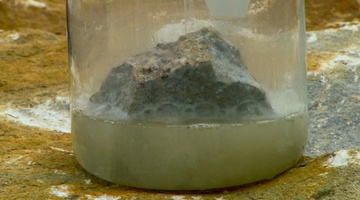Lime, produced by calcining limestone, plays a key role in a multitude of industrial, manufacturing and agricultural processes.
This interactive outlines the process steps taken at the McDonald’s Lime Limited Ōtorohanga plant. Click on the labels for more information.
Select here to view the full transcript and copyright information.

Discover how lime, produced by calcining limestone, plays a key role in a multitude of industrial, manufacturing and agricultural processes.
This interactive outlines the various process steps taken at the McDonald’s Lime Limited Ōtorohanga plant.
To use this interactive, move your mouse or finger over any of the labelled boxes and click to obtain more information.
Transcript
Step 1: Pre-extraction testing
Before quarrying a deposit, drill samples need to be carefully analysed to determine the quality of the deposit in terms of percentage of calcium carbonate present and absence of inert materials like silica and iron oxides.
Some of the quarry deposits are richer in calcium carbonate than others, and for calcination purposes it is essential that that correct grade of 97% calcium carbonate content and above be chosen.
Fines from the drill are collected, bagged and labelled and then sent to the on-site lab at the calcination plant for chemical analysis.
Acknowledgement:
McDonald’s Lime Limited
Step 2: At the quarry
After identifying the desirable limestone rock for extraction, a drill and blast method of extraction is used. An excavator loads the loosened limestone into dump trucks for delivery to the on-site crushing plant. This continuous-feed process crushes limestone chip into a range of sizes. Limestone chip 15–50 mm in size is sent to the calcination plant, while other sizes are used in other processes.
Acknowledgement:
McDonald’s Lime Limited
Step 3. Arrival at calcination plant
The chip is off-loaded and moved by conveyor belt to an intermediary stockpile.
From here, the chip is then moved to the preheater hopper where the chip needs to be preheated. First, it is loaded into the large hopper, and hot gas from the kiln at about 1000°C percolates through the chip.
After 4 hours in the preheater, large plungers push the hot chip into the upper portion of the rotary kiln. This preheating process is essential as it contributes markedly to the efficiency of converting limestone into lime.
Acknowledgement:
McDonald’s Lime Limited
Step 4. In the rotary kiln
The rotary kiln is 60 m long and 3 m in diameter. It rotates at 1 rpm.
Coal is ground to a fine powder, mixed with air and blown into the rotary kiln, where it ignites, producing the necessary heat.
Theoretically, to convert 1 tonne of limestone into lime, 3.17 GJ of heat energy is required, as the chemical reaction occurring is endothermic. However, due to energy losses through the process, the actual amount per tonne of limestone calcined is between 5 and 6 GJ.
The chip will be in the kiln for 2 hours. The temperature in the kiln ranges from 1200°C at the terminal end to 1000°C at the upper end.
Not all of the limestone is converted to lime. A small amount known as ‘loss on ignition’ (LOI) remains. This is about 0.5–1%.
Every hour, a sample of lime chip exiting the kiln is taken and sent to the on-site lab for analysis.
Acknowledgement:
McDonald’s Lime Limited
Step 5. Testing in the lab
The main analyses methods used in the lab are X-ray fluorescence and wet-lab titration.
A known mass of the sample is mixed with a flux and heated in a platinum crucible to 1030°C for 8 minutes, agitated and then heated for a further 5 minutes. The contents of the crucible are then poured into a preheated mould.
This is allowed to cool. The ceramic disc that results is then loaded into the XRF machine, which is programmed to analyse the sample for 11 elements found in their oxide form and reads out a percentage composition.
Two elements present in the lime are of concern to end-users such as the steel-making industry. High silicon content can cause wear and tear problems in the steel-making process due to the abrasiveness of silica. Sulfur can cause brittleness of the final steel product, so it needs to be very low in the lime used.
Samples from the kiln are also analysed for incomplete conversion to calcium oxide or loss on ignition.
Acknowledgement:
McDonald’s Lime Limited
Fiery Finkl Forging Creative Commons Attribution 2.0 Generic
Třineckéželezárny
Step Step 6. Lime chip processing
The lime chip exiting the rotary kiln falls on to a system of conveyors. Air is blown over the chip to cool it down. The hot air that results from this is blown back into the kiln.
The cooled chip is crushed to a powder, known commercially as ‘burnt lime’, and this is either bagged or loaded into shipping containers. Transport to customers is by either road or rail.
Acknowledgement:
McDonald’s Lime Limited
Step 7. Waste management
The gas stream exiting the kiln via the preheater is passed through a venturi water scrubber. This system removes particulate matter from the gas as well as several non-metal oxides such as sulfur dioxide. The remaining wet gas (28% carbon dioxide, 20% water vapour and the remainder mainly nitrogen) from the scrubber is then vented to the air via a 30 m chimney. As the wet gas cools, water condenses, forming a visible cloud of steam.
The wastewater is channelled to an on-site settling pond, and the solid material that collects is removed and placed in waste cells at the quarry.
Careful monitoring of the waste management systems is enacted to ensure that the calcination plant’s operation meet all of the national and local requirements for air, water and waste discharge.
Acknowledgement:
McDonald’s Lime Limited
United States Environmental Protection Agency



